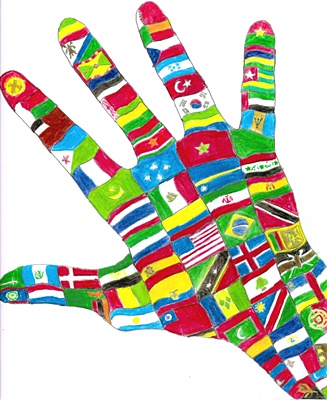All Nonfiction
- Bullying
- Books
- Academic
- Author Interviews
- Celebrity interviews
- College Articles
- College Essays
- Educator of the Year
- Heroes
- Interviews
- Memoir
- Personal Experience
- Sports
- Travel & Culture
All Opinions
- Bullying
- Current Events / Politics
- Discrimination
- Drugs / Alcohol / Smoking
- Entertainment / Celebrities
- Environment
- Love / Relationships
- Movies / Music / TV
- Pop Culture / Trends
- School / College
- Social Issues / Civics
- Spirituality / Religion
- Sports / Hobbies
All Hot Topics
- Bullying
- Community Service
- Environment
- Health
- Letters to the Editor
- Pride & Prejudice
- What Matters
- Back
Summer Guide
- Program Links
- Program Reviews
- Back
College Guide
- College Links
- College Reviews
- College Essays
- College Articles
- Back
Soy Americana: The Appropriation of Bilingualism
Soy Americana- so why is it questioned? Four months. Four months separate me from you. Four months keep me from running for president and four months keep me from being a “real” American. Four months after I was born, my family moved to the US. My parents’ leap of faith irreversibly changed my world, something that I am forever grateful for. While I may not have blonde hair or blue eyes, I am an American. Yet the media and growing anti-immigrant movement want me to apologize, to apologize for those four months and everything that it symbolizes and apologize for being me.
When I was in the first grade, my teacher told my parents they were not allowed to speak to me in Spanish at home. She claimed that it was hurting my English and preventing me from succeeding, despite the fact that I was one of the best at reading and English. My standardized test scores were almost perfect in English and reading. So my parents told her no and left. This is one of my earliest memories of being shamed for knowing Spanish, but it certainly wasn’t my last. Ask anyone who is a multilingual immigrant, stories of being treated like the class parrot, backhanded comments, and being the odd one out are common.
In these days plagued by the Kardashians and Trump, selective appropriation and mass xenophobia are an everyday part of life for anyone considered “other.” Facing daily micro-aggressions and outright hatred pressures many to abandon cultural and linguistic connections to family, while the mainstream trivializes both personal experiences and cultural practices. The dualism of being both an attraction to be ogled at and an oddity to shame is well known by kids who grow up bilingual. Comments of “how cool that must be” are paired with “why do your parents talk weird?” Multilingualism is constructive for everyone, but immigrants are disproportionally targeted for the “un-Americaness” of knowing more than one language.
Immigrants are discouraged from speaking their native language in favor of becoming monolingual in English. Despite the commonly accepted notion that multilingualism is beneficial (Worthy & Rodríguez-Galindo, 2006), teachers and other professionals tend to push only English onto recent immigrants. However, multilingualism is one of the trendiest ways to raise your child- if you are wealthy and a non-immigrant (Adamy, 2016). Once again, mainstream culture appropriates the characteristic of minorities while simultaneously shaming those minorities.
Researches working with Latino students of immigrant families found that the students worked hard to become proficient in English, with almost all of them abandoning Spanish along the way (Worthy & Rodríguez-Galindo, 2006). By talking with the families, researchers found that the complexities of language were not limited to purely academic variables (Worthy & Rodríguez-Galindo, 2006). Students felt social pressure to only speak English in addition to not having many opportunities to practice (Worthy & Rodríguez-Galindo, 2006). Even though the families’ first priority was for their children to become fluent in English, the parents also desired for their children to keep their culture (Worthy & Rodríguez-Galindo, 2006). The results indicated that the parents were an immense source of support and that teachers did not properly understand this (Worthy & Rodríguez-Galindo, 2006). In order to fix the issue, researchers suggest more acceptance of bilingualism, teachers being culturally educated, and better connection between home and school (Worthy & Rodríguez-Galindo, 2006).
While the popularity of bilingual schools increases, immigrant access to those schools remains stagnant (Adamy, 2016). Mostly charter or private, those schools tend to be fruit that looms too far from of the grasp of those who need it (Adamy, 2016). America’s one percent manufactures multilingualism while Americans born with it are shamed into submission. In an ever more hostile world, we as a nation must unite against hate. By putting in the effort of being more tolerant and patient with multilingual immigrants, we can grow into a more harmonious and successful people.
Adamy, J. (2016, April 1). Dual-Language Classes for Kids Grow in Popularity. Wall Street Journal. Retrieved from http://www.wsj.com/articles/dual-language-classes-for-kids-grow-in-popularity-1459535318
Worthy, J., & Rodríguez-Galindo, A. (2006). “Mi Hija Vale Dos Personas”: Latino Immigrant Parents’ Perspectives About Their Children’s Bilingualism. Bilingual Research Journal, 30(2), 579–601. http://doi.org/10.1080/15235882.2006.10162891

Similar Articles
JOIN THE DISCUSSION
This article has 0 comments.
